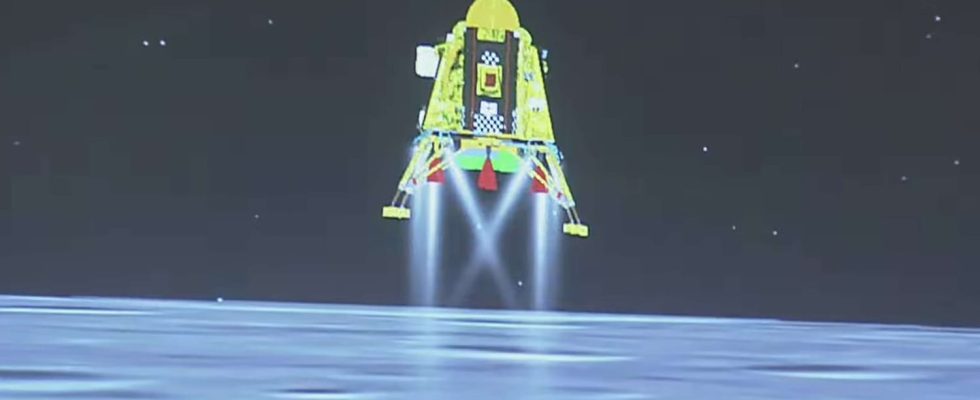CHANDRAYAAN-3. While the Indian probe landed smoothly on the south pole of the Moon yesterday, what will now be the program of its mission?
[Mis à jour le 24 août 2023 à 20h43] The Indian lunar mission called Chandrayaan-3, which means “moon ship” in Sanskrit, managed to deliver a lander and a small rover to the surface of the south pole of the Moon yesterday, Wednesday August 23 at 12:34 GMT, making India the 4th nation to land on our natural satellite and the first to achieve the feat of doing so on the rugged area that is its South Pole, three days after the failure of Russian Luna 25. “Chandrayaan-3 rover descended from lander and India walked on the Moon!”, the X account of ISRO, the Indian space agency, proudly announced , this Wednesday. Prime Minister Narendra Modi called the day before a “historic day” the success of the mission.
A region less explored by previous lunar missions than the north pole, the south pole of the Moon would house water in the form of ice, an essential resource for setting up a permanent base on the star. Time is now running out for Chandrayaan-3, as it was designed for a one-day lunar mission only, or two Earth weeks on the surface of the Moon.
What are the objectives of the Chandrayaan-3 mission?
On the one hand, its lander named Vikram, meaning “valour” in Sanskrit, must study the surface of the Moon, its seismic and thermal characteristics, its geology as well as the gases which make up its meager atmosphere. On the other hand, the Pragyan rover, meaning “wisdom” in Sanskrit, weighing 26 kg, focuses its efforts on studying the composition of the soil from a chemical and mineralogical point of view. Finally, the choice of a landing on the south pole of the Moon allows “India to explore if there is water ice on the Moon. This is very important for the cumulative data and the science on the geology of the moon”, explains Clara Filotico, partner and general manager of the consulting firm SpaceTec Partners, interviewed by Reuters.
Finally, the Chandrayaan-3 mission has a strategic stake since it is India’s first lunar mission and has enabled this country to become the 4e nation to land a probe on our natural satellite. India thus joins the United States, Russia and China in the very private circle of powers having landed on the Moon. The number one objective of the Chandrayaan-3 mission rover was first to demonstrate that India was capable of achieving “safe travel on the lunar surface”, reads on ISRO’s website.
 You can find more infographics at Statistics
You can find more infographics at StatisticsWhere did the Chandrayaan-3 probe land on the Moon?
For the landing of the Chandrayaan-3 probe, ISRO has selected a site that lies between the Manzinus C and Simpelius N craters. This place is located not far from the South Pole of the Moon, a very rugged region dotted with craters and reliefs where the maneuver is particularly difficult to carry out. Before reaching its landing zone, the probe completed several orbits around the Moon and then began its descent.
What photos are taken by the Chandrayaan-3 probe?
As the space probe circled the Moon before landing, Chandrayaan-3 captured a series of snapshots released by the Indian space agency using its onboard camera. We can see the hidden face of the Moon and its many craters:
Chandrayaan-3 is a space probe designed by the Indian space agency, ISRO, which was launched on July 14, 2023. Consisting of a lander that landed smoothly on the surface of the Moon and a a rover which descended from the landing module using an inclined ramp, this probe must meet several objectives and mark the entry of India among the nations to have placed a machine on the Moon.
To carry out its mission, the Chandrayaan-3 probe carries various instruments. The lander is notably equipped with a camera, a seismometer which studies the core of the Moon as well as several tools allowing it to carry out certain measurements at the level of the ground and the lunar atmosphere. For its part, the rover has two spectroscopes which study the chemical nature of the lunar soil as well as several cameras. This probe succeeds Chandrayaan-2 which crashed on the surface of the Moon in July 2019.
